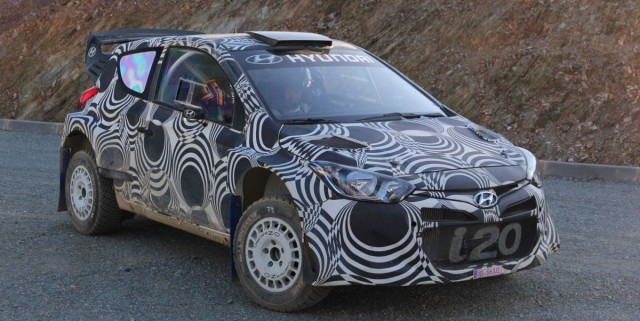
CarAdvice spoke with Hyundai WRC team principal Michel Nandan at the WRC test sessions in Spain about the challenges of developing a new motorsport program and Hyundai’s use of Australian Chris Atkinson as a factory test driver.
CA: It seems a lot of effort has gone into getting the Hyundai i20 homologated for the WRC series, so what will you be able to change as the season progresses and what needs to stay the same to keep it WRC compliant?
MN: You can change whatever item you want throughout the season, but there is an overall quota on how many items can be changed. For example, you can change pistons, but that will cost you one quota. Same with the camshaft.
Overall, there are three quotas for the engine, one for the software and three for the rest of the car. So there are seven possibilities to make significant changes to the car.
CA: This is the first time Hyundai has had its own motorsport program. Do have faith that the company will be committed enough to be successful in motorsport?
MN: Yes, for sure. In fact, they are really listening to us and the R&D centre in Namyang has already been very useful with a test bench, as well as all the aerodynamic development that has been done in South Korea. They’ve also helped us with all the simulation and calculation work has been done at Namyang.
CA: Which performance characteristics are targeted when you are developing a rally car from a road car?
MN: WRC regulations say the base car has to be as compact as possible, which is the reason all the manufacturers are using the [compact car] segment. You can change quite a lot as you can install a 4×4 transmission and play with the suspension, but you can’t change a lot on the pick-up points.
CA: What specifically are you working on during today’s test session?
MN: Today we have a different setup on the transmission and several differentials to test, as well as some suspension testing to help Chris get a good feeling with the car.
CA: So how much of it is a test of the driver’s abilities then?
MN: There are in fact aspects such as the differential performance and brakes that we are keen to test with different drivers, because we want different feedback from the various driving styles.
CA: What made you select Chris Atkinson as a factory test driver?
MN: Chris was selected for his experience and because he has a very good overview of all aspects of the WRC championship, which is really important for us. He has also driven a lot of different rally cars, which allows him to provide comparative feedback. So far, from the testing we have done he is giving us really good information on the car.
CA: Next year you are allowed 46 test days throughout the season, would you consider running two drivers and a third test driver?
MN: Yes, it makes sense for us to run two principle drivers as well as other test drivers, especially as we are developing a new car (new-generation i20) for 2015, which we will start testing around mid year.
I should add that next year is a big learning year for us and a time to prepare for the future – it is going require a full test team.
CA: What were the main challenges you had in developing this car?
MN: We have made some small changes along the way, but we have been quite lucky because our R&D centre started this project more than two years ago, while the base Hyundai i20 chassis was pretty good to begin with.
CA: Are you using a Hyundai production block?
MN: In the beginning we were using a derivation of the standard engine block, but the cylinder block is now specific to the WRC car.
CA: Are there things you wanted to do but weren’t been able to?
MN: By the end of this year we should have an engine test bench in the factory, so then we will be able to carry out specific engine development ourselves instead of outsourcing the work.





